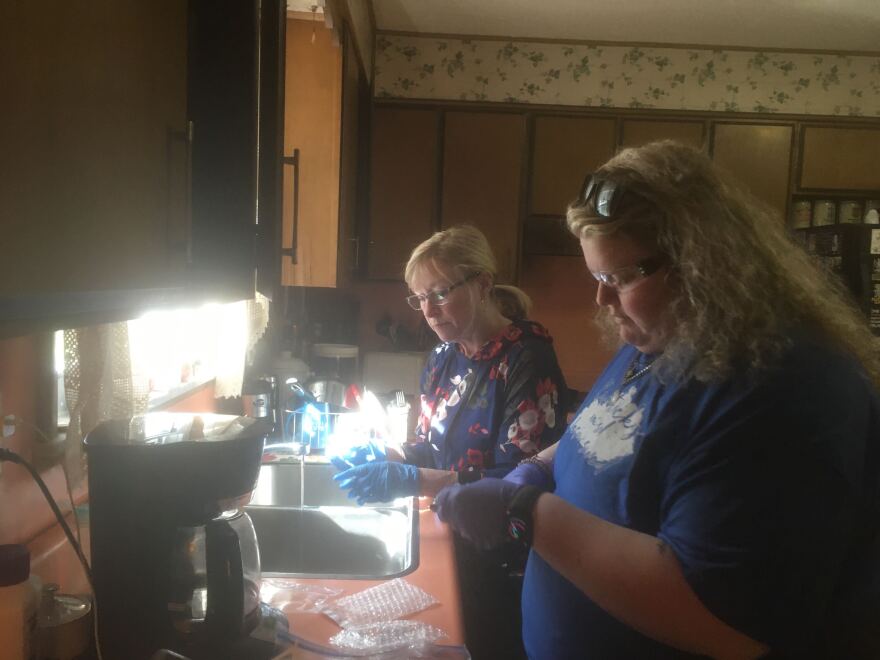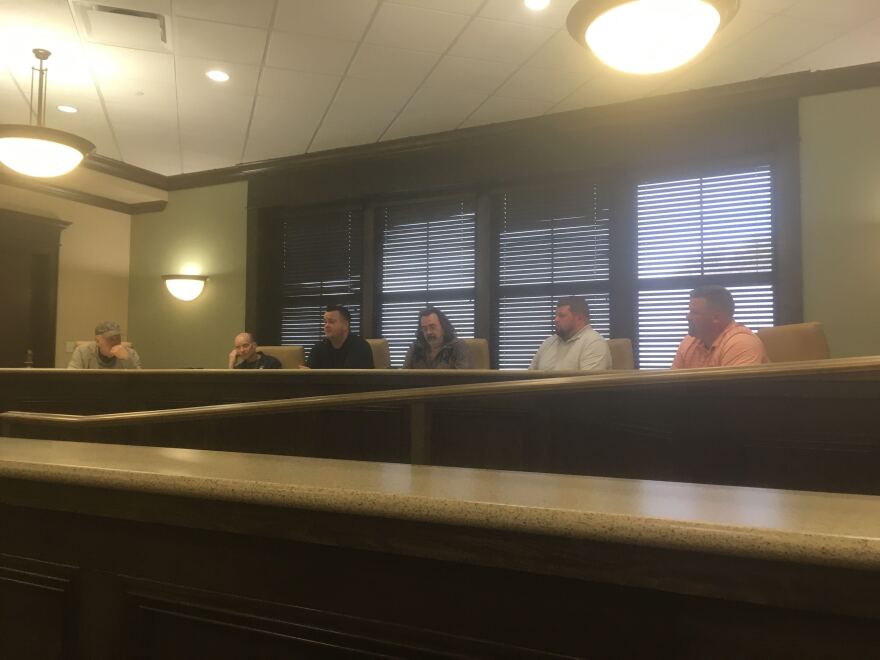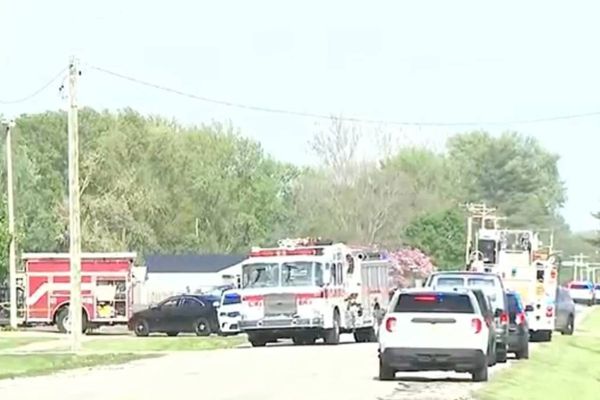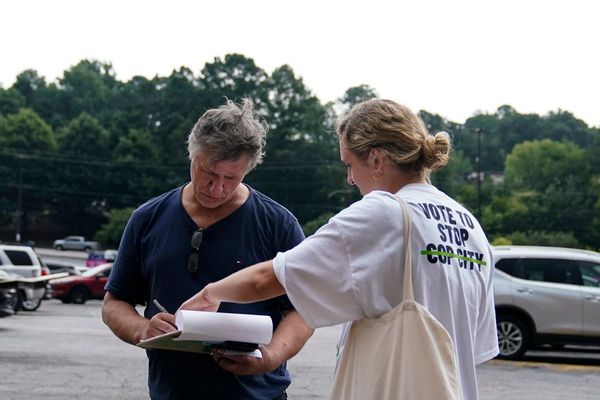
On a cool Tuesday in March, things heated up at the Martin County Water & Sanitation District monthly meeting. A delegation from the isolated Tomahawk community near the Johnson County line, sat opposite the water board, looking at board chair Jimmy Kerr with burning, furious eyes.
An older woman with a tight bun spoke, her words severe and sharp. Her name was Sue McGinnis.
“Della Barton,” McGinnis said, “she had to move out her home and take her mom that's lived their whole life that is sick, and has Alzheimer’s and sneaks out the house and won't go home, because they have no water and cannot take care of her.”
Tomahawk has no water lines. Residents once used wells, but coal industry activity muddied the water. A previous county administration, with federal grant funding from the Abandoned Minelands Fund, masterminded a temporary fix: a water vending machine that takes tokens purchased from the county. But over two months ago, the contraption was vandalized. Which means there’s no water at all, except the limited amount the county has begun to drop off for them every Friday. Like the token machine, it’s not a free service; customers pay in cash.
Another Tomahawk resident, Tammy Lewis, stood at the front and turned to the water board, who were arrayed behind a table and shifting uncomfortably in their chairs. She appealed to the board for a water line to her community, to end the mess once and for all.
“I mean, it's just been chaotic,” Lewis said. “The water situation’s chaotic. What do we do to try to get some results about this?”
After a moment, the board chair Kerr spoke out.
“I'm really sympathetic to your situation out there,” he said, apologetically. “I can say that I’ve thought about it a lot. And what we can do, you know, from a fiscal standpoint, for the water district, it's just not something that we can do…not at this time.”

Privately, water board members say they’re tired of being held as the poster child of water problems in the state, but there’s not enough money or resources to fix it all. The process of fixing Martin County’s water lines is frustratingly manual — patching leaks, digging up lines one by one to see if they’re broken and repairing them. It’s agonizingly slow and highly labor-intensive, requiring frequent water shutoffs and boil-water notices. As for laying an entirely new line? That’s out of the question in remote and small communities like Tomahawk. Resources are scarce, says the water board, and they’ve had to scrape for every penny. And everything’s a competition.
Martin County may have some name recognition, but it’s just one of many counties and towns across the country to eagerly await the grant funding from the federal bipartisan infrastructure bill. The bill, which was passed in November of 2021, has promised assistance to struggling communities for multiple issues, but in rural areas, one big focus has been water infrastructure. The money is promised to funnel through the states into local infrastructure authorities and development districts, and finally utilities–but there’s a lot of need, and communities that need the money the most worry they won’t get enough.
A squeeze on ratepayers
Before the March board meeting, Martin County community organizers Nina McCoy and Madison Mooney spent the day monitoring local waterways for metal, chemical, and bacterial contamination. As McCoy lifted a bottle of sample water from the stream, she recalled the latest development in the county — a rate hike, recently approved by the Kentucky Public Service Commission, set to raise county water rates to 85% above 2017 levels.
Martin County has a 34% poverty rate— over double the state average of 16%—but its people are now paying Kentucky’s highest base water bill. The measure was intended to offset an ongoing water loss rate that wavers between 70% and 80%. The US average water loss rate is roughly 16%.
The base rate for monthly water bills in Martin County is $70, but McCoy estimates many of her neighbors pay double that.Mooney agreed, saying she’s not sure how much farther it can go before people simply refuse to pay.
“Everybody’s on a fixed income as it is already,” Mooney said.
The water board insists the rate hikes are necessary to keep the district afloat, but, McCoy says, that won’t work if people can’t pay. If rates continue to rise, McCoy fears Martin County’s people will slide further into poverty, and the influx of federal funding won’t help as large municipalities with higher bidding power snap up grant money. She feels more intervention is needed to direct funds toward poorer water districts.
“Let's not just look at it as who can write up the prettiest grant. Let’s look at where the need is,” McCoy said.
Despite the rate hike, McCoy is cautiously optimistic about growing trust between local officials and ratepayers. Still, McCoy worries that for all the progress, inequality is built into the system.
“The money will go to the richest places like it always does,” McCoy said, as she looked out onto the reservoir that holds the county’s drinking water. “That's what I'm afraid of.”

A Crowded Room
Martin County isn’t the only county struggling with aging water systems–just one of the more famous ones. But being cash-strapped and sparsely populated has worked against it, despite the county’s demonstrated need.
University of Kentucky Professor Lindell Ormsbee leads the Kentucky Water Resources Research Institute. According to Ormsbee, there’s a lot of districts in the state and region that need big fixes for their systems. And they’re all competing for scarce resources.
“We have this problem with all these water utilities, we're now going to dump, you know, billions of dollars to try to help fix it,” Ormsbee said. “But we have a limited number of contractors that can do the work, right? There are a limited number of supplies, we have massive supply chain problems.”
There’s also a worker shortage — due to wage stagnation in water utility wages, advocates say, or perhaps population loss, or some combination of factors. Water line repair and construction jobs are demanding, and in places like Martin County, don’t often pay more than $13-$15 per hour. On top of that, the jobs require skill and training that is expensive for rural utilities to provide.

Ormsbee says that while federal money is available to fix the problem, the fixes rely on the free market to become reality. And contractors just may not be attracted to poor, rural counties with labor and supply challenges. He recalled one particular instance where lack of competition among contractors actually made things more expensive.
“You have someone that shows up to turn in their bid, on their way the parking lot,” Ormsbee said. “They're seeing if anyone else came. When they saw no one else came, they took their bid and just penciled in increases and all the costs because they know there's no competition.”
Kentucky received $250 million from the American Rescue Plan Act for clean water projects. But despite the county’s demonstrated need, which could be over $50 million, Martin County got a little under $412,000. The county operated from a lower grant rate because of its low population, which is just over 11,000.
According to the Kentucky Infrastructure Authority, this will not be the end of ARPA funding for Kentucky water districts. Two additional pots of funding totaling roughly $100 million are designated for underserved, rural communities. Grants will be awarded continuously until money runs out, and grant terms will run through 2024.
Meanwhile Kentucky is slated to receive $647 million from the federal infrastructure bill for clean water projects over the next four years. Funding from the bipartisan infrastructure bill will be released through the Drinking Water and Clean Water State Revolving Loan Programs, with an initial call for applications to be initiated in fall of 2022. Advocates worry the windfall is still outpaced by overall need and without more funding, ratepayers will continue to shoulder the burden.
After the March water board meeting ended, board members were more open about their frustrations.
Craig Miller is the director of Alliance Water, the private company appointed by the Public Service Commission to manage the county’s water system. He said politicians need to be realistic about how much help sweeping measures like the Infrastructure Bill will provide communities like Martin County.
“If you campaign or you use a community as a platform,” Miller said, “don't make me sit in meeting after meeting after meeting telling you what we've accomplished this week, this month, this year, and then hand me a $412,000, check and act like that's gonna make everything okay.”
Local officials know the competition for infrastructure bill grants will be stiff. So board chair Kerr is preparing to hit the ground running.
“It concerns me, somewhat, but I'm an optimist by nature,” said Kerr. “ I think if we are persistent enough that we will get our fair share.”







